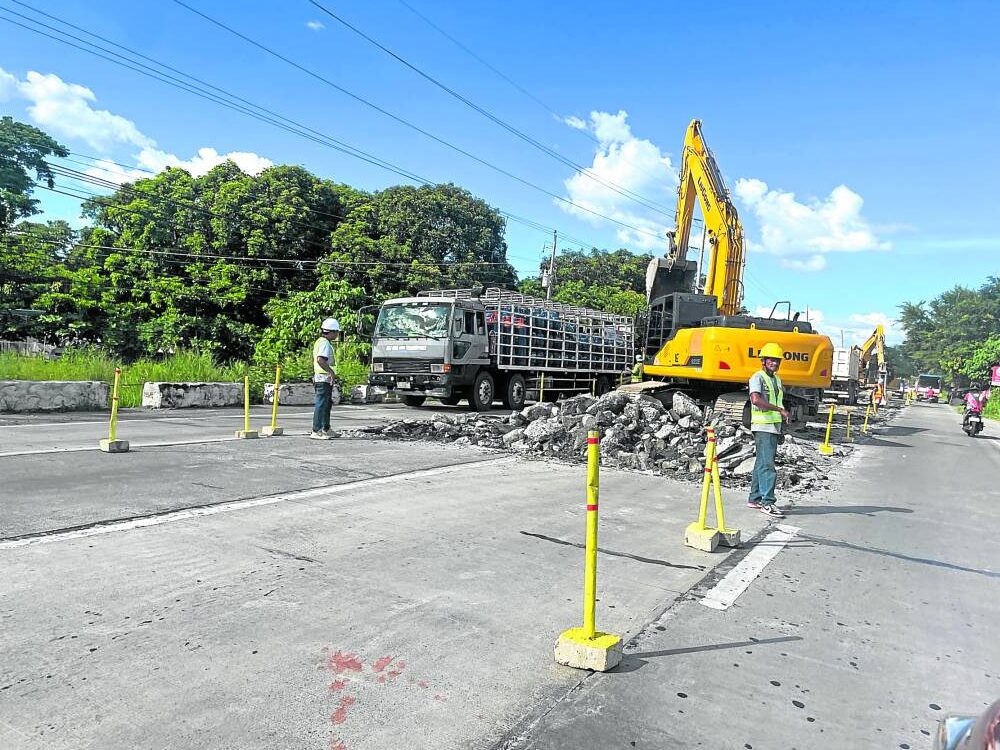
INCONVENIENCE This portion of Daang Maharlika (Maharlika Highway) at Barangay Luyang in Bayombong, Nueva Vizcaya, is one of several locations along the national highway where motorists are inconvenienced by hourslong delays due to road works. —Melvin Gascon
STA. FE, NUEVA VIZCAYA, Philippines — Motorists and residents in Cagayan Valley have called on the government to address the severe traffic congestion problem along several stretches of the national highway or Daang Maharlika (Maharlika Highway) in Nueva Vizcaya province, which has supposedly led to their undue suffering for the past two months.
Travelers blame the ongoing road works implemented by the Department of Public Works and Highways (DPWH), which, they said, are supposedly carried out with “little or no regard” for motorists’ safety and convenience.
“It’s such a shame that the province of Nueva Vizcaya has taken on the label of being the ‘traffic capital of Cagayan Valley’ because of all these [vehicle slowdown]. [Travelers] are greeted by traffic delays as soon as they enter Nueva Vizcaya in Sta. Fe [town] and will again be hampered by hours of delay as they leave [in Diadi town],” said Fidel Ibasco, a resident of Aritao town.
READ: Marcos to allocate P1.4B for Maharlika Highway rehab
Motorists complained that the DPWH and its project contractors had failed to manage traffic flow along the single-lane stretch of road works, often causing jams that would last for as long as eight hours.
Two locations where traffic jams were most severe were the ongoing road reblocking projects along the Maharlika Highway’s zigzag portion in this town, and in Diadi and Bagabag towns. Similar road projects in Bagabag, Solano, Bayombong and Bambang towns also cause traffic delays, although for shorter periods.
Documents obtained from the DPWH regional office show that the 100-kilometer stretch of the Maharlika Highway from this town to Diadi in the north has 38 road reblocking and widening projects, spanning a total of 39.24 km and worth more than P1.3 billion. Of the amount, the DPWH has allotted a total of P7 million for traffic management costs for the various projects, which was supposed to be used by the contractors to ensure smooth traffic flow.
Open letter
At the Sta. Fe project, motorists noted that the contractor converted the highway into a single-lane road stretching for more than a kilometer.
“Since the road is uphill, trailer trucks with heavy cargo would naturally crawl in negotiating that long stretch, causing longer wait,” said Norman Gapuz, a passenger bus driver.
Travelers bound for the Ninoy Aquino International Airport in Metro Manila and Clark International Airport in Pampanga province decried how they missed their flights due to the hours of delay while passing through Nueva Vizcaya. Others using private vehicles are forced to take alternative roads via the Nueva Vizcaya-Pangasinan road or the circuitous route that traverses the provinces of Quirino and Aurora.
In an open letter, businessman Wilson Salas urged the Nueva Vizcaya provincial board to make DPWH and its contractors explain the undue delays suffered by motorists.
“(The situation) leaves businesses involved in an unstable position. It adds to fuel costs, overtime pay of drivers and causes opportunity loss in the service sector,” he said.
Last month, Board Member Elma Pinao-an Lejao echoed criticisms from citizens who noted that in Nueva Vizcaya, the DPWH had started road repairs even if the highway, in their observation, was still in good condition.
“What is the life span of these roads being paved by the DPWH? Why is it that they are replacing the highways almost yearly?” she asked in a privilege speech.
Businesswoman Leoniever Palina of Diadi also confirmed that the stretch of the mountain highway in her town was undergoing repairs “almost yearly.”
Adjustments
Sought for comment, DPWH Cagayan Valley regional director Reynaldo Alconcel acknowledged that the contractor, Dalcon Enterprises, erred in closing a lengthy stretch of the highway here leading to Dalton Pass at the Nueva Vizcaya-Nueva Ecija border.
“We are making adjustments so that the curing period of the concrete would only be for seven days so that we can reopen the highway,” he said.
He warned project contractors not to scrimp for their traffic management activities, as these are included in the project cost.